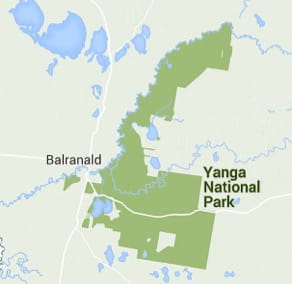Yanga National Park
Visitor info
All the practical information you need to know about Yanga National Park.
Getting there and parking
Get driving directions
From Balranald, take the Sturt Highway east for 7km. Turn south onto Old Sturt Highway at Yanga rest area. Turn left at the Yanga National Park sign and drive 2km along the main road where you will arrive at the park office and Yanga Homestead.
Park entry points
- Woolshed access See on map
- Yanga Lake access See on map
Parking Show more
- Regatta Beach picnic area See on map
- Yanga Homestead See on map
- Yanga Lake viewing deck See on map
- Yanga Woolshed See on map
- Yanga Woolshed picnic area See on map
Road quality
- Unsealed roads
Vehicle access
- 2WD vehicles
Weather restrictions
- Dry weather only
Best times to visit
The locals will tell you it can get pretty hot out this way, so you may wish to time your visit to avoid the summer heat. Temperatures during autumn, winter and spring are more moderate - just be sure to check the forecast as roads can become inaccessible in wet weather.
Spring
A great time to see the woodland birds - be sure to bring your binoculars.
Facilities
Toilets
- Mamanga campground
- Regatta Beach picnic area
- Yanga Homestead
- Yanga Woolshed
- Yanga Woolshed picnic area
Picnic tables
- Mamanga campground
- Yanga Homestead
- Yanga Lake Red Gum bird hide
- Yanga Lake viewing deck
- Yanga Woolshed picnic area
Barbecue facilities
Boat ramp
Maps and downloads
Permitted
Gathering firewood
Domestic firewood may be collected in designated areas of Yanga National Park from 1 April to 30 September with a permit. Permits are available to permanent NSW residents that live in the Riverina Bioregion and Balranald Shire. Learn more or apply for a permit.
Prohibited
Hunting and shooting native animals or poaching wildlife is prohibited. Report illegal activities.
Pets
Pets and domestic animals (other than certified assistance animals) are not permitted. Find out which regional parks allow dog walking and see the pets in parks policy for more information.
Smoking
NSW national parks are no smoking areas.

Contact
- in the Murray-Riverina region
Yanga National Park is open Sunrise to Sunset but may have to close at times due to poor weather or fire danger.
Yanga Homestead Precinct is open 8.30am - 4.30pm.
-
-
Yanga National Park office
03 5020 1764
Contact hours: 8.30am to 4.30pm daily. - 38773 Sturt Highway, Balranald NSW 2715
-
Email: npws.lowerdarling@environment.nsw.gov.au
-
Yanga National Park office
-
-
Buronga office
03 5021 8900
Contact hours: Monday to Friday, 8.30am to 4.30pm. - 4 Melaleuca Street, Buronga NSW 2739
-
Email: npws.lowerdarling@environment.nsw.gov.au
-
Buronga office
Nearby towns
Balranald (6 km)
Conveniently located on Sturt Highway as it crosses Murrumbidgee River between Sydney and Adelaide, Balranald is the perfect pit stop on a road trip through outback NSW. This small country town, with its rich pioneering past, is a gateway to Yanga National Park and the World Heritage-listed Mungo National Park.
Hay (124 km)
This exciting and innovative exhibition space uses contemporary design and cutting edge technology to tell the story of Australian sheep shearing. You'll meet the shearers, shed hands, cooks, classers, cockies, sheep and dogs behind the legends at this sparkling gallery-museum in Hay.
Mildura (168 km)
Mildura is set amid a diverse landscape on the Victorian side of the Murray River. The region is renowned for its long tradition of producing and serving fine food and wine at iconic restaurants, farmers markets, gourmet eateries and cellar doors.